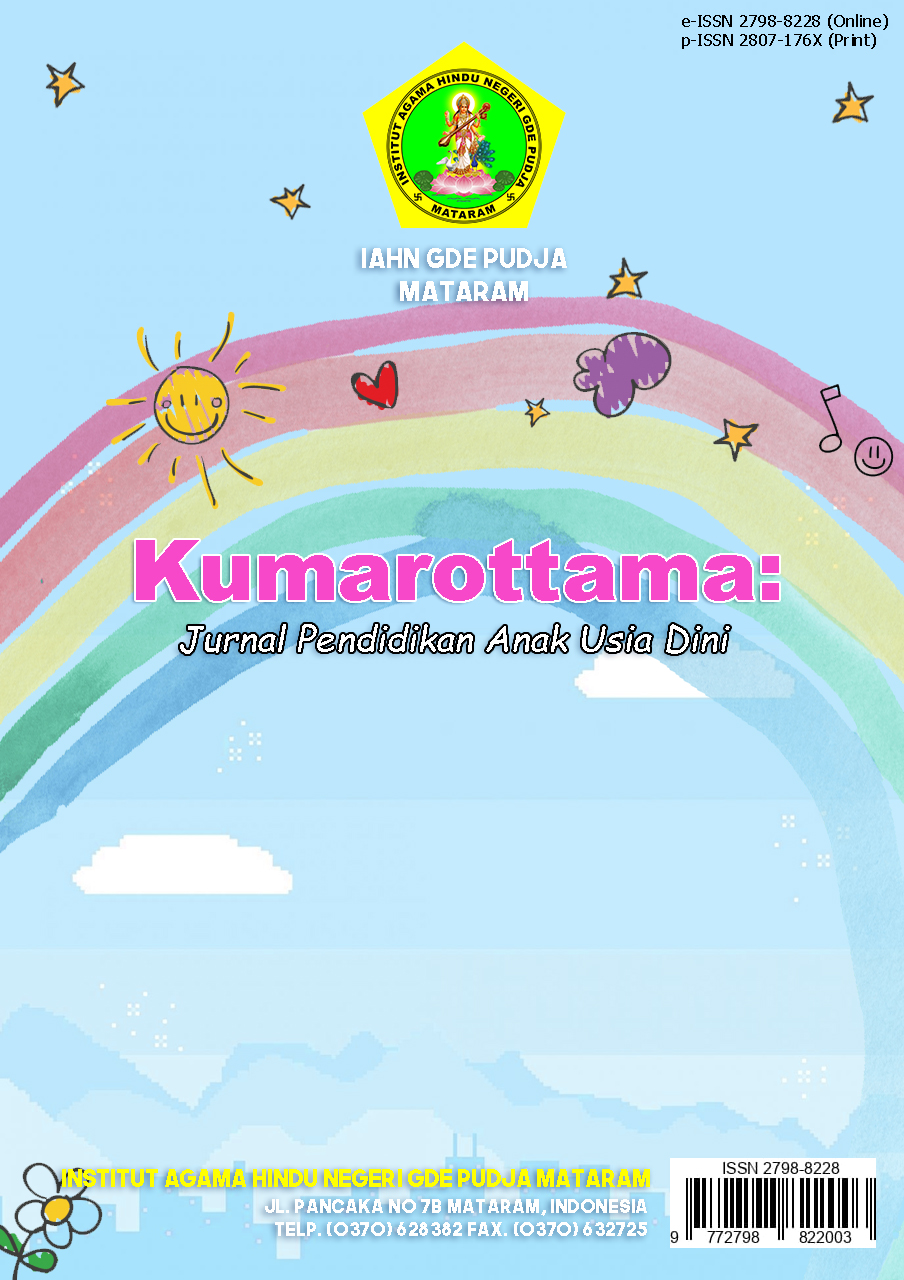PENGGUNAAN METODE HYPNOTEACHING MENGGUNAKAN PERMAINAN KARTU HEBAT TERHADAP KEMAMPUAN PERCAYA DIRI ANAK USIA 5-6 TAHUN
Abstract
The problem that is often faced by children is the ability of children's self-confidence which is still lacking, so it needs to be stimulated. One method that can be used to stimulate a child's self-confidence is the hypnoteaching method. The purpose of this study was to show whether there is an effect of the hypnoteaching method using great cards on the self-confidence of children aged 5-6 years. The research subjects were group B kindergarten children with a total of 38 children. Children's confidence instruments include: (1) Interacting with the teacher; (2) Express opinions in a simple way; (3) Make simple decisions; and (4) Demonstrating a willingness to appear in front of the class. The method used is a quantitative experimental research method. The experimental design used was quasi-experimental using a non-equivalent control group design. The tool used in this research is observation. In this research, data collection techniques used structured observation using observation sheets. Data analysis techniques used include normality test, homogeneity test and hypothesis testing using the Independent Sample T Test. Based on the calculation results, the significance value (2-tailed) is 0.000 <0.05, that Ha is accepted and Ho is rejected. So it can be seen that there is a significant effect of the hypnoteaching method using the Great Card game on the self-confidence of group B children. The treatment through the Hypnoteaching method using the Great Card game increases the child's self-confidence score, so that it can be said that the child's self-confidence can be stimulated by given positive suggestions and there is a gradual process of activity.
References
Anufia, Thalha Alhamid dan Budur. 2019. “No Title.” (INSTRUMEN PENGUMPULAN DATA):1–20.
Dini, Anak Usia. 2017. “Penerapan Bermain Untuk Membangun Rasa Percaya Diri Anak Usia Dini.” Journal Of Early Childhood and Inclusive Education 1:1–8.
Dwitasari, Putri, Nurina Orta Darmawati, Naufan Noordyanto, Vonny Aulia Sittasya, Weldiyanti Zulraniyah, Fathinah Dinda Raihanah, and Aprilia Annisa Karim. 2020. “Penggunaan Metode Observasi Partisipan Untuk Mengidentifikasi Permasalahan Operasional Suroboyo Bus Rute Merr-ITS.” Jurnal Desain Idea: Jurnal Desain Produk Industri Institut Teknologi Sepuluh Nopember Surabaya 19(2):53. doi: 10.12962/iptek_desain.v19i2.794.
Elburdah, Risza Putri, Derita Qurbani, Hestu Nugroho Warasto, Sutisman, and Sulaiman. 2020. “Loyalitas Kreativitas Abdi Masyarakat Kreatif Loyalitas Kreativitas Abdi Masyarakat Kreatif.” Jurnal LOKABMAS Kreatif 01(03):81–86.
Fitri, Ruqoyyah. 2017. “Metakognitif Pada Proses Belajar Anak Dalam Kajian Neurosains.” Jurnal Pendidikan (Teori Dan Praktik) 2(1):56. doi: 10.26740/jp.v2n1.p56-64.
Fransisca, Ria, Sri Wulan, and Asep Supena. 2020. “Meningkatkan Percaya Diri Anak Dengan Permainan Ular Tangga Edukasi.” Jurnal Obsesi : Jurnal Pendidikan Anak Usia Dini 4(2):630. doi: 10.31004/obsesi.v4i2.405.
Hidayatun Nisa, Riska. 2019. “Pengaruh Penggunaan Media Ludo Terhadap Hasil Belajar Matematika Materi Bangun Ruang Siswa Kelas V Sd.” Jurnal Penelitian Pendidikan Guru Sekolah Dasar 7(3):2909–19.
Iii, B. A. B., Metode Dan, and Desain Penelitian. 2012. “Restu Arti Setia, 2014 penerapan model pembelajaran kooperatif tipe numbered heads together (nht) terhadap kemampuan berpikir kritis peserta didik pada mata pelajaran kearsipan Universitas Pendidikan Indonesia | Repository.Upi.Edu | Perpustakaan.Upi.Edu.”
Isti`adah, Feida Noorlaila. 2020. Teori- Teori Belajar Dalam Pendidikan. Pertama. Jawa Barat: Edu Publisher.
Kemendikbud, RI. 2014. “Standar Isi Tentang Tingkat Pencapaian Perkembangan Anak.” Peraturan Menteri Pendidikan Dan Kebudayaan Republik Indonesia Nomor 137 Tahun 2014 1–31.
Kusumawati, Wahyu Surya, and Mas’udah. 2019. “Pengaruh Media Puzzle Terhadap Kemampuan Kognitif Mengenal Konsep Bilangan Pada Anak Kelompok A Di Tk Dharma Wanita Ngraseh Kecamatan Dander Kabupaten Bojonegoro.” 1–5.
Montolalu, Chriestie, and Yohanes Langi. 2018. “Pengaruh Pelatihan Dasar Komputer Dan Teknologi Informasi Bagi Guru-Guru Dengan Uji-T Berpasangan (Paired Sample T-Test).” D’CARTESIAN 7(1):44. doi: 10.35799/dc.7.1.2018.20113.
Maulidiyah. 2018. “Penanaman Nilai-Nilai Agama Dalam Pendidikan Anak Di Era Digital.” Martabat: Jurnal Perempuan dan Anak Vol. 02 No.01
Rohmah, Jazilah. 2018. “Pembentukan Kepercayaan Diri Anak Melalui Pujian.” Martabat: Jurnal Perempuan Dan Anak 2(1). doi: 10.21274/martabat.2018.2.1.117-134.
Roswendi, Achmad Setya, and Denok Sunarsi. 2020. Dinamika Dan Hypnotherapy Dalam Perspektif Interdisipliner. Saleh, Gunawan. 2018. “Pengaruh Komunikasi Interpersonal Guru Dalam Meningkatkan Rasa Percaya Diri Anak Usia Dini.” Medium 6(2):51–61. doi: 10.25299/medium.2018.vol6(2).2411.
Ulfa, Noviana Mariatul. 2020. “Analisis Media Pembelajaran Flash Card Untuk Anak Usia Dini.” Genius 1(1):34–42. doi: 10.35719/gns.v1i1.4.
Usmadi, Usmadi. 2020. “Pengujian Persyaratan Analisis (Uji Homogenitas Dan Uji Normalitas).” Inovasi Pendidikan 7(1):50–62. doi: 10.31869/ip.v7i1.2281.
Usta, H. Gonca. 2017. “Examination of the Relationship between TEOG Score Transition (from Basic to Secondary Education), Self-Confidence, Self-Efficacy and Motivation Level.” Journal of Education and Practice 8(6):36–47.
Utami, Rafida Wahyu Tri, and Moh Hanafi. 2018. “Pengaruh Metode Bermain Peran Terhadap Peningkatan Percaya Diri Pada Anak Usia Pra Sekolah (4-5 Tahun) Di Pendidikan Anak Usia Dini Insan Harapan Klaten.” Jurnal Keperawatan Soedirman 12(2):84. doi: 10.20884/1.jks.2017.12.2.694

This work is licensed under a Creative Commons Attribution-ShareAlike 4.0 International License.
Authors who publish with this journal agree to the following terms:
- Authors retain copyright and grant the journal right of first publication with the work simultaneously licensed under a Creative Commons Attribution-ShareAlike 4.0 International License that allows others to share the work with an acknowledgement of the works authorship and initial publication in this journal.
- Authors are able to enter into separate, additional contractual arrangements for the non-exclusive distribution of the journals published version of the work (e.g., post it to an institutional repository or publish it in a book), with an acknowledgement of its initial publication in this journal.
- Authors are permitted and encouraged to post their work online (e.g., in institutional repositories or on their website) prior to and during the submission process, as it can lead to productive exchanges, as well as earlier and greater citation of published work (See The Effect of Open Access).











.png)














